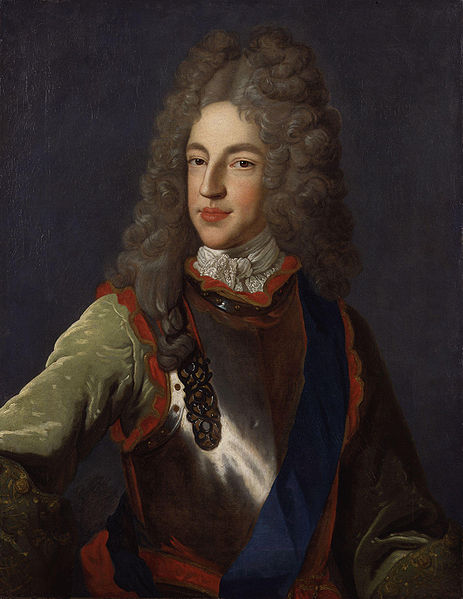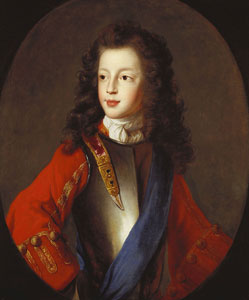<Back to Index>
- Ornithologist Hermann Schlegel, 1804
- Painter Jean Désiré Gustave Courbet, 1819
- Prince James Francis Edward Stuart, 1688


Prince James, Prince of Wales (James Francis Edward Stuart; "The Old Pretender" or "The Old Chevalier"; 10 June 1688 – 1 January 1766) was the son of the deposed James II of England (James VII of Scotland). As such, he claimed the English, Scottish and Irish thrones (as James III of England and Ireland and James VIII of Scotland) from the death of his father in 1701, when he was proclaimed king of England, Scotland and Ireland by his cousin Louis XIV of France. Following his death in 1766 he was succeeded by his son Charles Edward Stuart in the Jacobite Succession.
From the moment of his birth, on 10 June 1688, at St. James's Palace, the prince was the subject of controversy. He was born to the reigning king, James II of England (and VII of Scotland), and his Roman Catholic second wife, Mary of Modena, and as such was automatically Duke of Cornwall and Duke of Rothesay among other titles. The Wars of Religion were fresh in the minds of the populace, and many British feared a revived Catholic dominance of the government. James II had two adult daughters from his first marriage who had been raised as Protestants. As long as there was a possibility of one of them succeeding him, his opponents saw his rule as only a temporary aberration. When people began to fear that James's second wife, Mary, would produce a son and heir, a movement grew to replace him with his elder daughter Princess Mary and his son-in-law/nephew, William of Orange. When the young prince was born, a rumour immediately spread that a call for a warming pan had been the pretext for a substitution, implying that James and Mary's baby was allegedly stillborn. On 10 December, within six months of his birth, Mary of Modena took baby James to France, worried about his safety, while his father continued to fight (unsuccessfully) to retain his crown. James and his sister Louisa Maria, were brought up in France. There, James was recognised by his cousin, King Louis XIV of France, as the rightful heir to the English and Scottish thrones and became the focus for the Jacobite movement.
On his father's death in 1701, he declared himself King, as King James III and VIII and was recognised as such by France, Spain, the Papal States and Modena. These states refused to recognise William III, Mary II or Queen Anne as legitimate British sovereigns. As a result, he was attainted for treason on 2 March 1702, and his titles were forfeited under English law. Having been delayed in France by an attack of measles, James attempted an invasion, trying to land at the Firth of Forth on 23 March 1708. His French ships were driven back by the fleet of Admiral Sir George Byng. Had
he renounced his Roman Catholic faith, he might have strengthened the
existing support of Tory, pro-Restoration forces in England, but he refused to do so. As a result, in 1714, a German Protestant became King — George I of Great Britain. In 1713, the War of the Spanish Succession ended
indecisively although the French forces and allies (of which Spain was
one) were in complete control of Spain itself, they failed to retake
the Spanish Crown's other European territories. Louis XIV of France accepted peace with England and her allies. He signed the Treaty of Utrecht, in 1713, that, amongst other conditions, required him to expel James from France. In the following year, the Jacobites started "The 'Fifteen" Jacobite rising in
Scotland, aimed at putting "James III and VIII" on the throne. In 1715,
James finally set foot on Scottish soil, following the indecisive Battle of Sheriffmuir, but was disappointed by the strength of support he found. Instead of
going through with plans for a coronation at Scone, he returned to
France, sailing from Montrose. He was not welcomed back, because his patron, Louis XIV, was dead and the government found him a political embarrassment.
Pope Clement XI offered James the Palazzo Muti in Rome as his residence, and he accepted. Innocent XIII, like his predecessor, showed much support. Thanks to the mediation of a close friend of his, Cardinal Filippo Antonio Gualterio, James was granted a life annuity of eight thousand Roman scudi. Such help enabled him to organise a Roman Jacobite court, where the Pope's cousin, Francesco Maria Conti of Siena, was the Gentiluomo di camera (Chamberlain). On 3 September 1719, James Francis Edward Stuart married in the Chapel of episcopal palace of Montefiascone (Viterbo -Italy), Maria Clementina Sobieska (1702–35), granddaughter of the Polish king, John III Sobieski. They had two sons. Initially a daughter of Philippe d'Orléans, Mademoiselle d'Orléans, had been suggested as a wife for James Francis Edward Stuart. Following James's failure, attention turned to his son Charles, "the Young Pretender",
whose rebellion of 1745 came closer to success than his father's. With
the failure of this second rebellion, however, the Stuart hopes of
regaining the British throne were effectively destroyed. James and
Charles later clashed repeatedly, and relations between them broke down
completely when James played a role in the election of his son Henry as
a Cardinal (the celibacy required meaning that Henry would not have any children and could not carry on the line of succession) infuriating Charles who had not been consulted. In 1759 the French government briefly considered a scheme to have James crowned King of Ireland, as part of their plans to Invade the British Isles but
the offer was never formally made to James. Several separate plans also
involved Charles being given control of a French-backed independent
Ireland. James died in Rome on 1 January 1766, and was buried in the crypt of St. Peter's Basilica at the Vatican. His burial is marked by the Monument to the Royal Stuarts. Refusing to recognise James's eldest son Charles, from 14 January the Papacy instead accepted the Hanoverian dynasty as
the legitimate rulers of Britain and Ireland, although it was as late
as 1792 that they specifically referred to George III as the King of
Great Britain and Ireland, leading to a Protest from James's second
son, Henry. James'
64 years, 3 months and 16 days as the Jacobite pretender to the thrones
of England, Scotland and Ireland lasted longer than the reigns of any
legitimate monarch of those kingdoms or their successor states. To
date, the longest serving British monarch is Queen Victoria,
who reigned for 63 years, 7 months and 2 days. In order to surpass the
record set by the titular James III, the current monarch Queen Elizabeth II would need to remain on the throne until at least May 23, 2016.